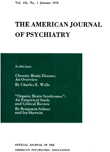A STATISTICAL STUDY OF FIRST ADMISSIONS WITH PSYCHONEUROSES IN NEW YORK STATE, 1949-1951
Abstract
Though they undoubtedly constitute one of the largest categories of mental disorders, the psychoneuroses represent a small proportion of hospitalized cases. It is common knowledge that many psychoneurotics, even without treatment, carry out their social obligations. Others are treated privately, and therefore do not enter into hospital statistics. But of the unknown total of psychoneurotics, some, because of the severity of symptoms, are hospitalized. The records of the New York State Department of Mental Hygiene show that first admissions with psychoneuroses to the civil State hospitals have grown to approximately 4% of the total first admissions, and represented a rate of 4.3 per 100,000 population in 1954. As an indication of their social status, it may be noted that almost half are admitted to the licensed hospitals, in contrast to only 20% of all first admissions.
First admissions with psychoneuroses were admitted to all mental hospitals in New York State at an average age of 38.2 years. The average annual rate was 8.0 per 100,000 population. The rate rose to a maximum of 16.1 at ages 30 to 34. At all ages, females, generally, had higher rates than males.
Urban populations had higher rates than the rural populations. It is significant, however, that New York City had a lower rate than the remaining urban population. This was due, in part, to several large aggregates of population in New York City, who do not encourage treatment for what they consider minor disorders.
In general, only a small percentage of first admissions are described as being in comfortable economic circumstances. A third of the psychoneurotics, however, fall in this category. The only other comparable groups are those with involutional psychoses and manic-depressive psychoses. Some support for this conclusion is found from rates of first admissions according to occupation. Groups high in the occupational scale appear to have high rates of first admissions with psychoneuroses.
The higher social status of psychoneurotics is also seen through a consideration of degree of education. Thus, only 45% of all white first admissions, aged 25 years and over, had been to high school or college, whereas these degrees of education had been attained by two-thirds of the first admissions with psychoneuroses. In fact, 20% of the latter had been to college. The rate of first admissions among psychoneurotics was higher for those with some degree of high school or college education than for those with no education or only elementary education.
With respect to marital status, the highest rate of first admissions occurred among the divorced, followed by the separated. The lowest rate occurred among the married.
The rate for Negroes was approximately a third of that for whites, despite the fact that the total rate of first admissions for Negroes is greatly in excess. It is not known at present whether the lower rate for psychoneuroses represents a racial characteristic. It is probable, however, that hospitalization for psychoneuroses is less likely to occur among Negroes, because of the greater tolerance exercised by the Negro community in this respect.
Jews have a higher rate of first admissions with psychoneuroses than the remaining non-Jewish white population.
Native whites residing in New York State, but born in other states have a higher rate than native whites born in and residing in New York State. This is interpreted as showing that migrants have a higher rate than non-migrants.
Access content
To read the fulltext, please use one of the options below to sign in or purchase access.- Personal login
- Institutional Login
- Sign in via OpenAthens
- Register for access
-
Please login/register if you wish to pair your device and check access availability.
Not a subscriber?
PsychiatryOnline subscription options offer access to the DSM-5 library, books, journals, CME, and patient resources. This all-in-one virtual library provides psychiatrists and mental health professionals with key resources for diagnosis, treatment, research, and professional development.
Need more help? PsychiatryOnline Customer Service may be reached by emailing [email protected] or by calling 800-368-5777 (in the U.S.) or 703-907-7322 (outside the U.S.).



